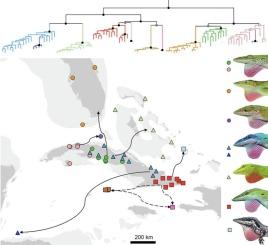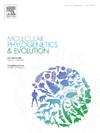单一来源岛屿的跨水扩散形成了绿蜥亚群的多样性。
IF 3.6
1区 生物学
Q2 BIOCHEMISTRY & MOLECULAR BIOLOGY
引用次数: 0
摘要
古巴绿变色蜥是卡罗莱纳变色蜥物种复合体的成员,是加勒比地区变色蜥最成功的殖民谱系之一。我们利用ddRAD和Sanger序列数据来澄清A. carolinensis物种复合物(通常称为古巴绿变色蜥)所有成员之间的进化关系,划分物种边界,并解释这一高度分散的变色蜥关键群体的地理起源。这项研究支持“离开古巴”假说,该假说涉及六到七次来自古巴的独立殖民事件,其中一次可能是开曼群岛和纳瓦萨之间的岛屿到岛屿的分散事件。独立的殖民事件发生在古巴西部、中部和东部三个主要分支。西古巴的血统曾两次分散到萨尔滩(巴哈马群岛)和佛罗里达。古巴中部的血统两次分散到巴哈马群岛和海湾群岛(洪都拉斯),后者似乎是由于人类的援助。东古巴血统曾经殖民过巴哈马群岛以及小开曼群岛和纳瓦萨群岛,尽管尚不清楚这些殖民地是否都直接来自古巴。我们建议继续识别除a . fairchildi(我们认为是a . porcati的一个亚种)外的所有物种,该类群共有8种:a . allisoni, a . brunneus, a . carolinensis, a . longiceps, a . maynardii, a . porcatus, a . smaragdinus和a . torresfundai。本文章由计算机程序翻译,如有差异,请以英文原文为准。

Overwater dispersal from a single source island shaped the diversity of green anole lizards (Anolis carolinensis subgroup)
The Cuban green anoles, members of the Anolis carolinensis species complex, are among the most successful colonizing lineages of anole lizards in the Caribbean. We use ddRAD and Sanger sequence data to clarify the evolutionary relationships among all members of the A. carolinensis species complex (generally called Cuban green anoles), demarcate species boundaries, and explain the geographic origins of this key group of highly dispersive anoles. This study supports the “Out of Cuba” hypothesis involving six or seven independent colonization events from a Cuban source with one possible island-to-island dispersal event between the Cayman Islands and Navassa. Independent colonization events occurred from three main clades delimited by western, central, and eastern Cuba. West Cuban lineages dispersed twice—to the Cay Sal Bank (Bahamas) and to Florida. Central Cuban lineages dispersed twice—to the Bahamas archipelago and the Bay Islands (Honduras), respectively, with the latter seemingly owing to human assistance. East Cuban lineages colonized the Bahamas archipelago once as well as Little Cayman and Navassa, although it is unclear if all these colonizations occurred directly from Cuba. We recommend continued recognition of all species in the complex except A. fairchildi—which we consider a subspecies of A. porcatus—for a total of 8 species in this group: A. allisoni, A. brunneus, A. carolinensis, A. longiceps, A. maynardii, A. porcatus, A. smaragdinus, and A. torresfundorai.
求助全文
通过发布文献求助,成功后即可免费获取论文全文。
去求助
来源期刊
CiteScore
7.50
自引率
7.30%
发文量
249
审稿时长
7.5 months
期刊介绍:
Molecular Phylogenetics and Evolution is dedicated to bringing Darwin''s dream within grasp - to "have fairly true genealogical trees of each great kingdom of Nature." The journal provides a forum for molecular studies that advance our understanding of phylogeny and evolution, further the development of phylogenetically more accurate taxonomic classifications, and ultimately bring a unified classification for all the ramifying lines of life. Phylogeographic studies will be considered for publication if they offer EXCEPTIONAL theoretical or empirical advances.

 求助内容:
求助内容: 应助结果提醒方式:
应助结果提醒方式:


